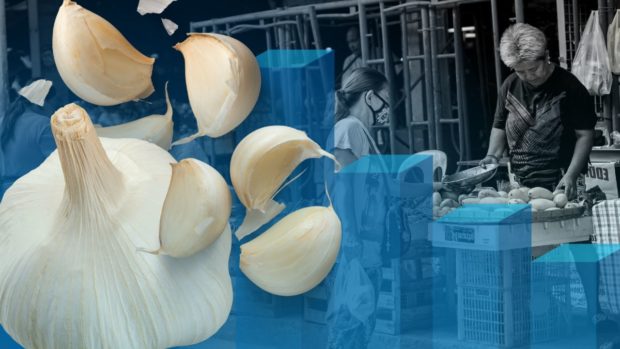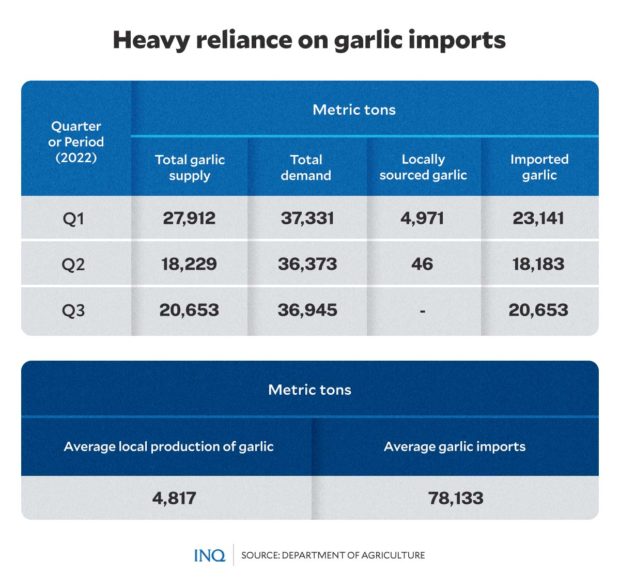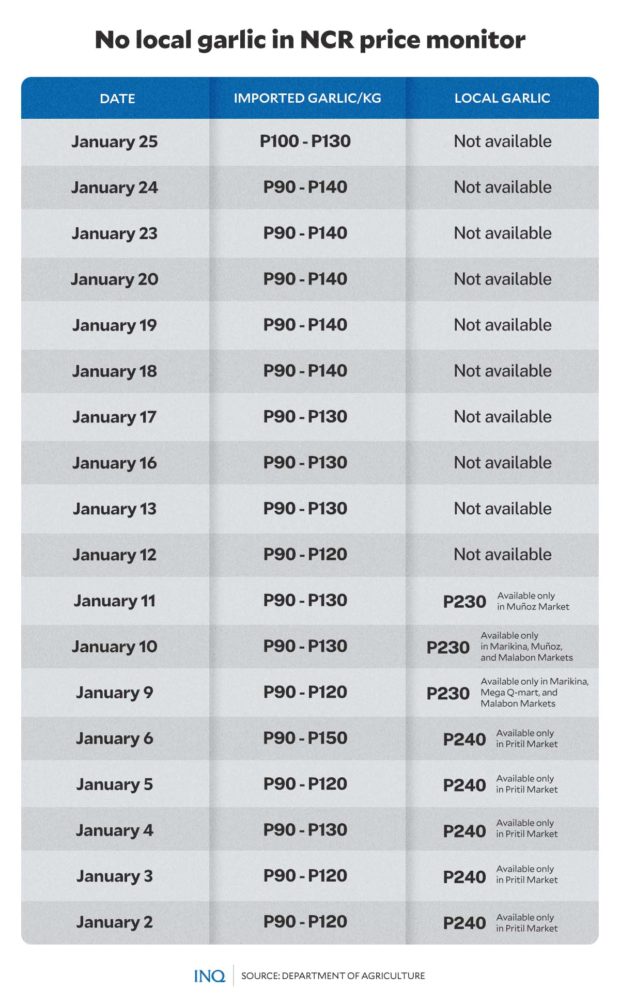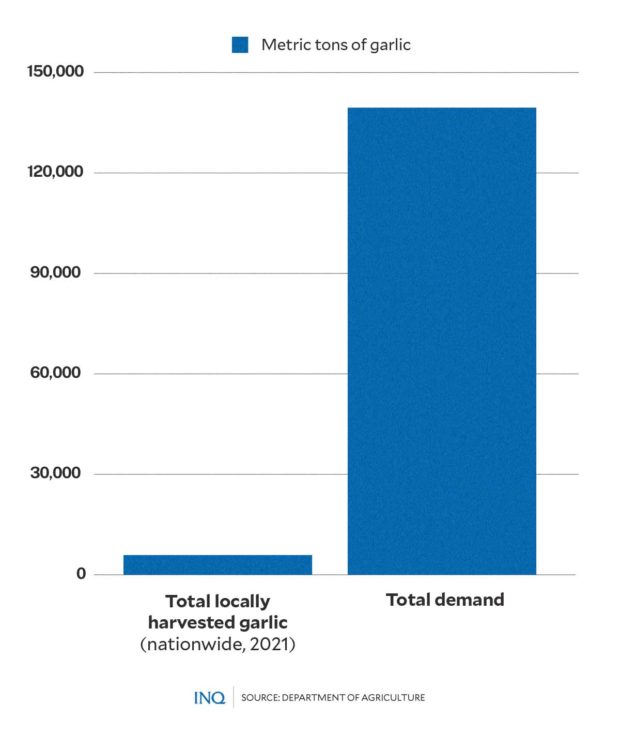Inexplicable price hikes, supply confusion: After onion, garlic may be next
MANILA, Philippines—While Filipino consumers slowly try to recover from months of inexplicably high onion prices, some are now bracing for higher costs of another kitchen staple—garlic—as a supply shortage lurks around the corner.
With the first batch of imported onion arriving recently, consumers are given a breather in prices that had gone up to as much as P700 per kg at one point.
READ: First shipment of 1,200 MT imported onions now in PH
The Department of Agriculture’s (DA) price monitoring also showed that current retail prices of locally grown red and white onions had decreased slightly to P200-P350 compared to the all-time high retail price of P700 per kilogram during the holiday season.
READ: Onion prices worldwide much lower, deepen questions on incredulous costs in PH
Article continues after this advertisementHowever, just as many people began to expect more stir-fry dishes again—with affordable onions now available—consumers recently noticed yet another round of increasing prices for a different essential vegetable, this time, garlic.
Article continues after this advertisementIn a recent statement, the DA said more garlic consumers continue to prefer purchasing imported garlic sold at around P80 per kilo, than locally grown and harvested bulbs sold at around P300 per kilo.
Garlic supply shortage
In some markets in Metro Manila, vendors attributed the increasing cost of locally produced bulbs to low supply.
According to the DA, inventory for the local produce in the market has “significantly shrunk as last year’s supply was ‘almost used up’ by the series of holidays of December.”
“Garlic sold this month was sourced from the very last harvest of 2022, which was in early November,” the agriculture department said in a statement.
But as early as August last year, officials have already warned about the inadequate supply of native garlic, which they feared would not be able to meet the demand for 2022.
In a hearing of the House Committee on Food and Agriculture, the DA said there would only be around 83,000 metric tons (MT) of local garlic by the end of 2022. Compared to the estimated demand of 146,850 MT that year, the supply would be 63,000 MT short.
Data from the Bureau of Plant Industry (BPI) noted that the Philippines, in past years, has been heavily dependent on garlic imports to meet local demand. For instance, in the third quarter of 2022, the total supply of 20,653 MT was all imported, but the country still needed more to meet the total demand of 36,945 MT.
READ: PH heavily reliant on garlic imports to meet demand
Separate data released by the DA also showed that in 2021, total locally harvested garlic reached 5,890.14 MT—still not enough to meet the 139,509 MT demand for garlic that same year.
According to Raul Montemayor, chair of the Federation of Free Farmers Cooperatives Incorporated (FFFCI), local garlic production has indeed been “going down consistently over the years.”
Citing data from the Philippine Statistics Authority (PSA), Montemayor said that local production of garlic accounted for only 9 percent of total supply in 2018. This figure, however, slid to a lower 6 percent in 2021.
Imported garlic: Problem or solution?
The decline in locally harvested garlic these past few years, Montemayor stressed, could be attributed to the increasing amount of imported bulbs entering the country.
“This was mainly due to the decision of many farmers not to plant garlic anymore due to the influx of cheap garlic from Taiwan, China, and other countries, which were being sold for only 1/2 (half) to 1/3 (one-third) of prices of native garlic,” he told INQUIRER.net.
“It is possible that the DA was again unable to properly monitor supplies and ensure the timely arrival of imports since harvests usually start only in March,” he added.
In a recent interview over GMA-7’s 24 Oras, the DA regional office in Ilocos Region—considered as the Philippines’ garlic capital—said the government cannot help but import more due to the supply issue.
From the first to the third quarter of 2022, the country imported 61,977 MT of garlic.
“We are not sufficient at all when it comes to garlic. We are dependent on importation. Its sufficiency is admittedly a problem we’ve been facing. Improvement in production yield and quality of our garlic is also something that we have to work on,” Kristine Evangelista, agriculture undersecretary for consumer affairs and spokesperson, told lawmakers last year.
However, as the DA acknowledged the thinning supply of garlic last year, some provinces reported an “oversupply” of garlic. In Lubang, Occidental Mindoro, reports noted that stocks of harvested garlic were left to rot due to a lack of buyers.
Batanes Gov. Marilou Cayco also confirmed this and appealed to the government and the public to buy locally-grown bulbs. In an interview, she said she was worried that local farmers would stop producing the crop if there were no buyers.
“I feel sorry for the farmers. They might be discouraged from planting if their products are not sold,” Cayco said.
READ: Batanes seeks buyers amid garlic glut
In a report by Vera Files, Danilo Fausto, president of the Philippine Chamber for Agriculture and Food Inc., explained that the oversupply of agricultural products in some provinces amid the reported supply shortage could be due to a “problem of logistics.”
“With the Philippines being an archipelago, Fausto said it is harder to ship some products across islands. Batanes, for one, is the smallest province in the country, both in area and population. Located in the northernmost part of the country, it is essentially closer to Taiwan than to the northern tip of Luzon,” the report said.
“This, according to Fausto, leads to a ‘disconnect’ between the farmers and their target markets,” it added.
Consumers prefer cheaper bulbs
With garlic demand still rising amid the wide price deficit between local and imported bulbs, the DA has observed that more buyers are forced to opt for the imported variety over the local produce.
“Buyers stressed that practicality dictates them to buy the cheap big bulbs over the small native ones, even if the latter has a stronger aroma and is more flavorful,” said the DA in a statement.
From January 12 to January 26, the DA’s price watch—which monitors 13 major wet markets in Metro Manila—did not include the retail price of local garlic. In the latest price watch, imported garlic has a retail price ranging from P90 to P130 per kilo.
READ: Imported garlic being sold cheaper than local ones — DA
On January 11, a kilo of native garlic cost P230, which is significantly lower than the P300 per kilo retail price that the DA mentioned in its recent statement.
“Given the economic hardship many Filipinos are facing, it is only natural that they will look for cheaper substitutes. There is still a market for native garlic. But supply is limited, so prices are much higher,” Montemayor explained.
He also noted that traders might have been hoarding stocks again to drive prices up, “knowing supply levels are running low by this time before the next harvests come in.”
What can be done?
“The ulterior motive is to bring down prices to control inflation, and this means flooding the market with cheap imports even during harvest time,” said Montemayor.
“But traders do not want prices to go down. So they manipulate stocks and prices to maximize their profits,” he added.
He stressed that in order to truly help farmers who are losing over cheaper imported garlic, the DA should have a comprehensive approach which he said involves planting materials, inputs, credit, cold storage, inventory financing, market linkage, and others.
He also added that the government must ensure reasonable prices and incomes for local garlic farmers. Achieving this, however, may require controls over imports for some time.
“The more we flood the market with cheap imports, the less incentive for our farmers to produce. If the [government] maintains this policy, the local garlic industry will die a natural death. Whatever happens, traders and importers could still manipulate stocks and prices at the expense of consumers.”
TSB
RELATED STORIES:
What we know so far about ‘out of control’ rise in onion prices
The PH onion conundrum: Solutions elusive, stop-gaps at best



